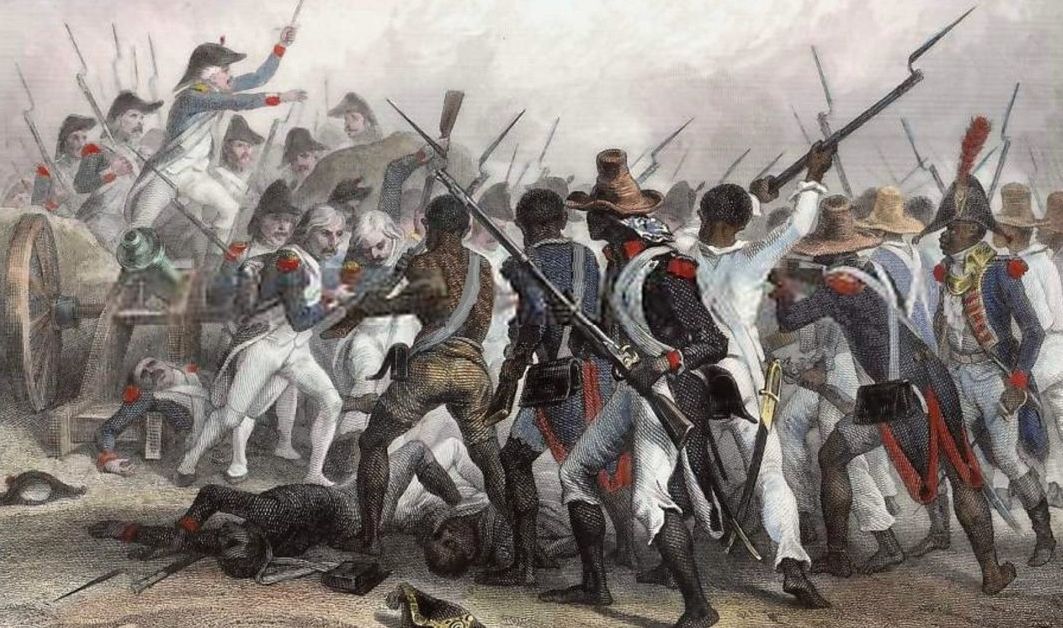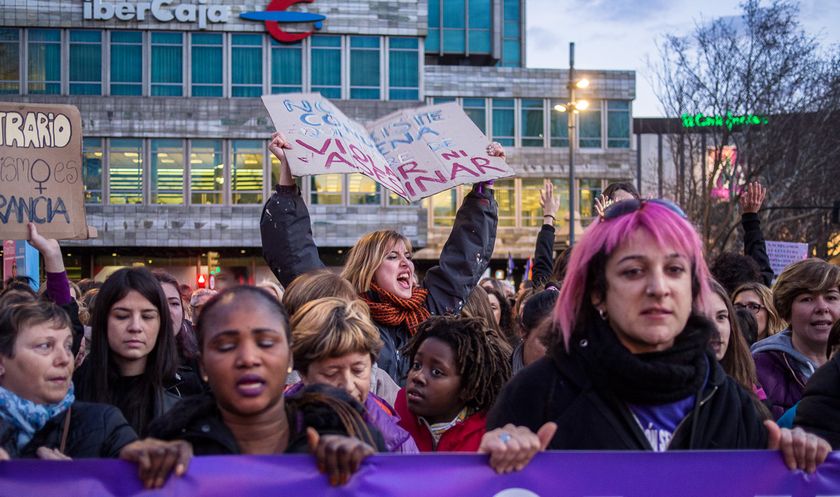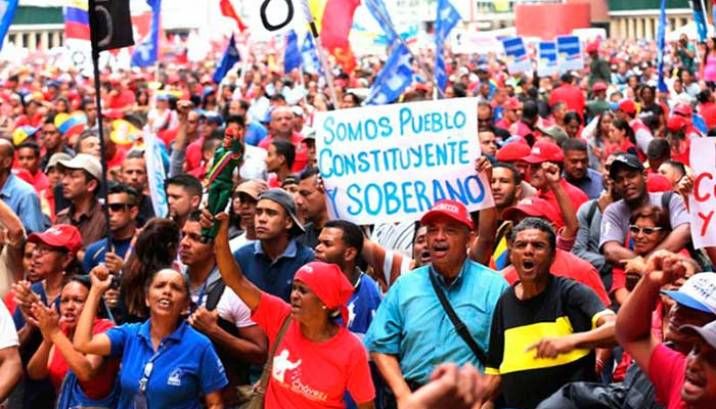Max Toynbee is a member of Socialist Alternative (England, Wales & Scotland).
Review of The Black Jacobins by C.L.R. James (published 1938)
Most schools teach pupils that the Atlantic slave trade went against European “enlightenment” principles of rationality, equality and democracy; a horror perpetrated against docile and simple Africans that was abolished by high minded powerful European leaders in a peaceful and democratic way. With calls to decolonize curricula in Britain and beyond, C.L.R. James’ scintillating history of the revolution in the Caribbean country of San Domingo (now Haiti) cuts through these myths, disentangling the dynamics of race and class with a sharp Marxist analysis.
The Haitian revolution is largely absent from the British history curriculum with the exception of some forward thinking schools. The increasing centralization and standardization of the curriculum, for example through a narrow range of textbooks, controls what is taught. Perhaps the story of how black slaves, with solidarity from many white Europeans, overthrew their exploiting slave masters against multiple imperialist powers is knowledge too dangerous for the capitalist class!
The origins of the revolution – The Atlantic slave trade
In the first chapter “The Property”, James charts the rise of slavery in San Domingo, serving as a useful case study for the development of the Atlantic trade in general. “The Property” he is referring to is of course the slaves themselves. He explains how the brutal, dehumanizing regime of slave owners was not a result of individual “bad apples” who were “naturally” cruel but rather a systematic terror perpetrated by all slaves owners to a greater or lesser degree, designed to keep slave resistance in check. Against the claim by some that Africans sold other Africans into slavery and therefore bear much of the responsibility for the slave trade, James points out how white Europeans in West Africa burned crops and exploited local rivalries and class conflicts so that many Africans had to “provide slaves or be sold as slaves themselves”. Similarly, James highlights the continued resistance of Africans before, during and after enslavement; in fact quelling this resistance was the main reason why the white European slave owners adopted such a diabolical regime.
The second chapter “The Owners” explores the class society that existed in San Domingo including the “big white” major slave-owners, the “small white” petit-bourgeois slave-owners and the “Mulattoes” (children of black slaves who had been raped by their white owners) who owned slaves and plantations but were also discriminated against by the whites. The antagonisms between these groups were based on both class and race – the Mulatto population of San Domingo were described as a distinct racial group by the white ruling class in order to act as a bulwark against the black slaves. This whole racialized social system was designed to set each group against one another (Mulattoes against black slaves and against the “small whites” etc) in order that the big white owners and French bourgeoisie could extract huge profits from the unpaid labor of the black slaves.
James goes on to explain the international context of competing imperialist powers (France, Britain, Spain and the newly independent USA). Far from abolishing slavery out of high-minded morality, the British Prime Minister William Pitt asked the now celebrated MP William Wilberforce to lead the abolition movement as a way to undermine French imperialism which then rested on slave labor in San Domingo. In fact, as soon as the British believed they could secure the colony for themselves, they once again supported slavery. The treachery and hypocrisy of the imperialist powers in opportunistically pushing for abolition or supporting slavery depending upon what suited their own national ruling class is a key theme of the book.
The masses: France and San Domingo
“The blacks were taking their part in the destruction of European feudalism begun by the French Revolution, and liberty and equality, the slogans of the revolution, meant far more to them than to any Frenchman.”
James illustrates the interdependence of the French and San Domingo revolutions, a connection ignored in most history classrooms. As the French Revolutionary ideals of “liberté, egalité, frenterité” spread to San Domingo the Mulattoes, ever discriminated by the whites, wanted a piece of the action. Some leaders of the French revolution claimed to support “the universal rights of men” but did not include Mulattoes or black people in their conception of “men”. In May 1791, the Mulattoes and “free blacks” demanded equal rights in the National Assembly in France. Some concessions were granted which then raised the question: if free blacks and Mulattoes should have equal rights, shouldn’t this apply to the black slaves too?
Leadership: Toussaint L’Overture
“Personal ambition he had. But he accomplished what he did because, superbly gifted, he incarnated the determination of his people never, never to be slaves again.”
Most schools tend to elevate the role of individual “brilliant” leaders (e.g. Wilberforce) in the struggle against slavery, emphasizing individual agency over the importance of the wider social structure. The revolution was led by former slave, Toussaint L’Overture. Whilst James acknowledges that Toussaint was an inspirational and rare talent, this talent was developed and moulded into a revolutionary leader by the context of the socio-economic situation. Not only does an exceptional individual make a revolution, but so too a revolutionary situation moulds and pushes leaders into action. As James writes:
“We have clearly stated the vast impersonal forces at work in the crisis of San Domingo. But men make history and Toussaint made the history that he made because he was the man that he was.” (p91)
Toussaint was in a relatively privileged position compared to other slaves, having responsibility to supervise a team and being able to teach himself to read and write. In the initial slave insurrections in 1791, Toussaint initially defended his master’s plantation from rebels but when he saw how powerful the slave insurrection was he decided to join it – realizing the huge power of the black masses. He was a skilled political and military leader and was well respected by the former slaves. Because black slaves and former slaves made up the vast majority of the colony’s population, they fought in both the revolutionary and counter-revolutionary (British and Spanish) forces. Toussaint was able to build his army by appealing to the rank and file of enemy troops and convincing them to join him with limited bloodshed: “All they [counter-revolutionary British and Spanish] could offer was money and there are periods in human history when money is not enough.” (P153)
San Domingo was devastated by this civil war and, after black slaves had been freed, Toussaint implemented a harsh regime on the black laborers in order to restore agricultural production. He was also very kind to the white plantation owners, letting them keep their property so that they would provide their much needed skills in restoring the plantations. The vast majority of the population were illiterate and consequently lacking in the specific skills and knowledge needed to run the plantations. Major efforts were made to expand education but in the meantime they had to use the skills of their former exploiters. Toussaint didn’t really explain to the former slaves why he was treating the whites so well which created some resentment, given the brutal treatment the black laborers had experienced from their former masters. James makes an interesting comparison with Lenin here, who also had to utilize the skills of those who had formerly worked against the revolution in Russia due to the low level of education there too:
“But whereas Lenin kept the party and the masses thoroughly aware of every step, and explained carefully the exact position of the bourgeois servants of the Workers’ State, Toussaint explained nothing, and allowed the masses to think that their old enemies were being favored at their expense.”
So the laborers were now paid and were promised a quarter of what they produced, but many were confused and angry at how their former white masters were getting preferential treatment. Of course one major difference between the Russian and Haitian examples is the existence of a revolutionary party. This is the organization through which the situation can be explained and policy democratically formulated. The lack of such an organization in Haiti contributed to Toussaint’s failure to explain the favorable treatment of the whites to the masses.
The revolution triumphs
In October 1801 Napoleon Bonaparte, realizing that France might lose San Domingo, sent General Leclerc to the colony. Secretly, Bonaparte instructed Leclerc to reinstate slavery and get rid of all black troops who held rank above captain. Again, despite having abolished slavery due to pressure from the French masses and in order to rescue San Domingo from the British and Spanish, Bonaparte had no qualms about reinstating slavery if that was needed to boost the French economy.
Leclerc and his French troops embarked upon another destructive war on the Caribbean island, with Toussaint letting his supporters know that Leclerc intended to restore slavery. Jean-Jacques Dessalines, another great leader of the revolution, fought bravely against the French even when greatly outnumbered. However Toussaint had suffered losses, partly as a result of his above-mentioned errors in creating resentment amongst the black masses. He surrendered to Leclerc, who arrested him, killed his family and sent him to die alone in a cold prison cell in the French Alps.
By August 1802, news that Bonaparte had restored slavery in nearby islands such as Martinique reached San Domingo, fanning the flames of anger against the French. A general insurrection spread through the island once again and by October 1802 the black leaders Dessalines and Henry Christophe raised a revolutionary army with mostly black officers and rank-and-file soldiers. Blacks and Mulattoes began to form a national identity around their common goal of expelling the French. By the end of 1803 this revolutionary army had defeated the French and on January 1, 1804, Dessalines proclaimed Haiti’s independence. Slavery was finally abolished in France in 1848. This was not a result of liberal minded leaders finally realizing the wrongs of slavery but rather of the revolutionary masses; workers in solidarity with the slaves, once again wielding their collective power.
Class, race and racism: Tools of the bourgeoisie
“This was no question of color, but crudely a question of class, for those blacks who were formerly free stuck to the Mulattoes. Persons of some substance and standing under the old regime, they looked upon the ex-slaves as essentially persons to be governed.”
The relationship between class and race is a striking feature of the book. Rather than taking a purely “class determinist” line, race is viewed as interwoven with class in order to maintain the power of the exploiters. The Mulattoes wavered between supporting and attacking Toussaint not due to their mixed black and white heritage but because of their intermediate social position – when they believed the counter-revolutionary pro-slavery forces best represented their interests, they supported them but when this was not the case, they supported Toussaint. Often different groups of Mulattoes supported different sides. Likewise the black laborers were united not purely by the color of their skin but by their economic and physical oppression they had all experienced as slaves. There were cases of solidarity by white soldiers, such as a regiment of Poles who had been sent to Haiti to fight against the revolution, refused to join a massacre of blacks.
Another recurring theme is the role of the bourgeoisie in supporting slavery and racism. The imperialist powers of England and Spain only supported the rebelling slaves in order to try and get San Domingo for themselves – they had no intention of freeing slaves in their other colonies and it was clear they would try to reinstate slavery in San Domingo had they suceeded in taking the colony. Similarly, the French government did not abolish slavery in 1794 due to high-minded Enlightenment morals but as a way of beating back the English and Spanish. In fact, the French abolition of slavery was the reason Toussaint switched sides from the Spanish back to the French.
Similarly, racism is and was created and amplified by the bourgeoisie in order to support their interests. They will whip up racism if it serves their interests. Gabriel Hédouville (brutal French imperialist) stirred up racial hatred between the Mulattoes and blacks in order to prevent them from working together. Likewise, the white French General Leclerc did the same between blacks and whites in order to prevent his white European troops siding with the black laborers. After independence, the British said they’d only trade with the Haitian regime if they massacred the whites. The British wanted this to drive a wedge between the newly independent Haitian state and France so as to damage trade relations. Time and again racial tensions were created, reinforced and inflamed whenever this suited the needs of the bourgeoisie.
White leaders such as Hédouville and Thomas Maitland underestimated Toussaint at great cost. Similarly, Bonaparte refused to believe that the black former slaves were capable of achieving independence themselves – he did not provide adequate military support to Leclerc to fight against the revolution and later regretted not reaching a compromise with Toussaint. Their racist arrogance actually undermined their own cause – a case where racism wasn’t even beneficial to those supposed to benefit from it!
Lessons for today: Decolonizing the curriculum, C.L.R. James’ legacy and Haiti today
There are some educators who believe slavery should not be taught, or perhaps be taught less in schools as it presents a negative portrayal of black history. It’s certainly true that other aspects of black history need to be taught, such as the powerful ancient empires of Africa, the movements against colonialism and the contribution of people of color to other areas of history. However, James’ approach to the topic of slavery focuses less on the depravities African captives were forced to endure and instead emphasizes the agency of black people themselves in resisting slavery from the outset and in achieving freedom and independence from European imperialism in Haiti. The books doesn’t treat slavery as “black history” but rather something inseparable from “white” European history; slavery was part of the emerging world system of capitalism and the revolt of the black slaves contributed to the overthrow of feudalism in Europe, just as the white European masses contributed towards the abolition of slavery.
The fact these connections are not made in most history classes is illustrative of an Eurocentric curriculum which intentionally ignores the agency of people of color to transform society. History under capitalism also ignores that it has been mass struggle by working class and poor people which has been the motor force for change. This is no accident. The movement to decolonize the curriculum should not aim to see “black” history as distinct from “white” history but rather demand that schools teach about the connections between people of color and white people, as well as the role of mass movements and revolutions. The idea of “black history” is useful to make visible that which has been systematically ignored, but The Black Jacobins shows how the fundamental questions in history are about the power to change society of those who actually do the meaningful work in society – whether slaves or wage laborers.
C.L.R. James was a Trotskyist at the time he wrote Black Jacobins, James developed Pan-Africanist ideas and believed that the liberation movements of oppressed minorities should be a focus for the work of revolutionaries. His work, including his disagreements with Trotsky, are particularly relevant for discussion today with the rise of the Black Lives Matter movements, for the liberation of LGBT+ people and other oppressed minorities.
Meanwhile, Haiti today is described by the World Bank as the poorest country in the Western Hemisphere. In 2019 its Human Development Index ranking was 169 out of 189 countries. Capitalist commentators blame this on a combination of corruption and the natural disasters Haiti has been ravaged by (earthquake and hurricanes) but the impacts of these so called “natural” disasters are not inevitable. Haiti’s lack of preparation, compared to say, Japan, and the spread of diseases following these disasters are amplified by the abysmal poverty of such an underdeveloped nation. Haiti’s poverty is a result of the imperialist punishment of the world’s only successful revolution of enslaved Africans in the era of the Atlantic trade continued after the revolution right up to the present day. [In 1825, France, with warships at the ready, demanded Haiti compensate France for its loss of slaves and its slave colony. Haiti paid the modern equivalent of $21 billion to France. It took until 1947 for Haiti to finally pay off all the associated interest of the debt.]
American imperialism, through economic blockades, support for various pro-US militia and even outright occupation, has ensured the economic underdevelopment of Haiti, once the most productive French colony. The conscious punishment of Haiti aims to warn other potential revolutionaries – “This is what happens when you step out of line.”
The book ends with an optimistic call to arms to the oppressed masses of Africa, with James pointing out the revolutionary potential of that great continent. Overall this is a fantastically engaging and exciting book to read with lessons for all about this earth shattering but often ignored revolution.



